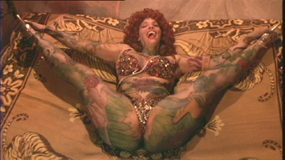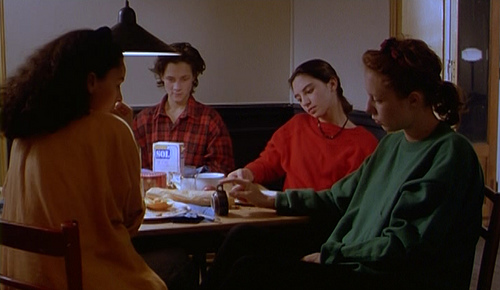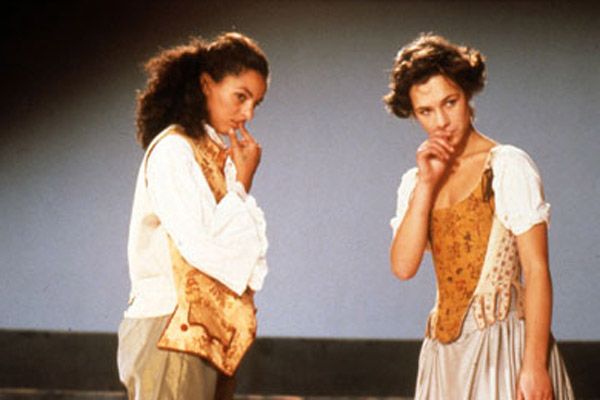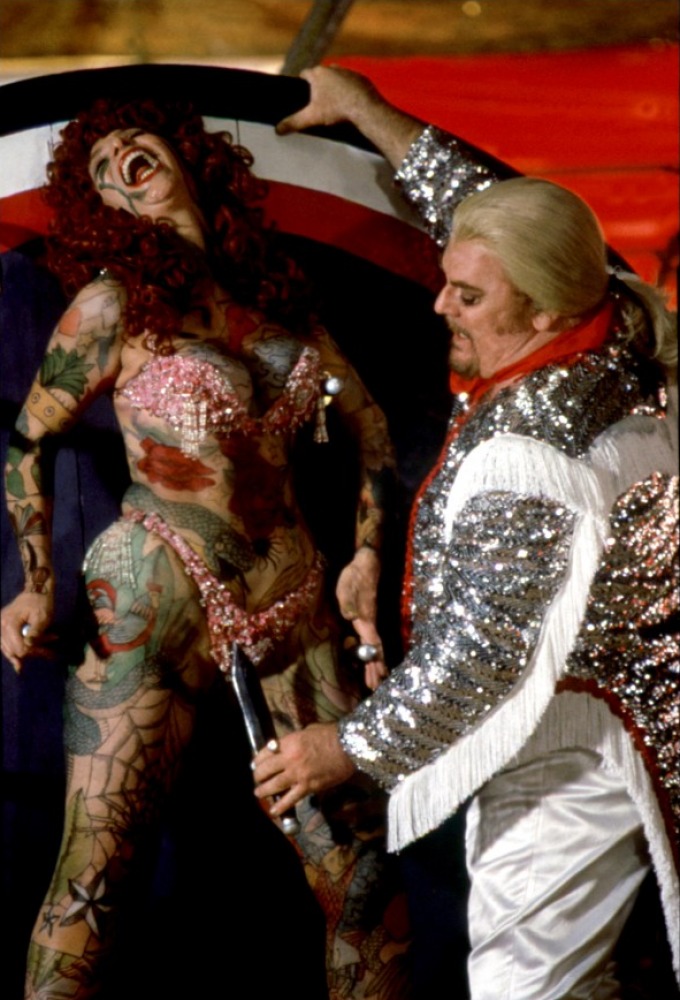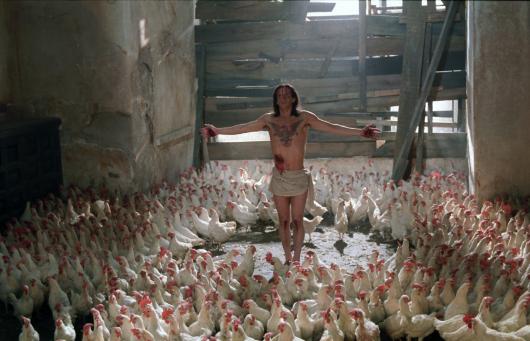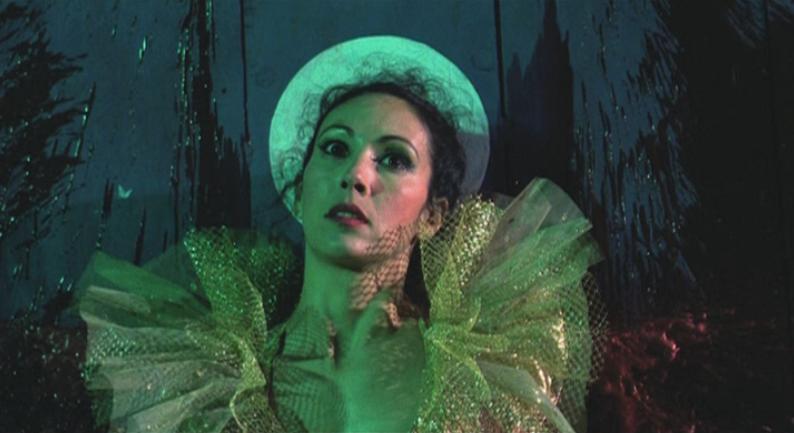From the Chicago Reader (June 22, 1990). — J.R.
THE GANG OF FOUR
*** (A must-see)
Directed by Jacques Rivette
Written by Rivette, Pascal Bonitzer, and Christine Laurent
With Bulle Ogier, Benoit Regent, Laurence Cote, Fejria Deliba, Bernadette Giraud, Ines de Medeiros, and Nathalie Richard.
SANTA SANGRE
* (Has redeeming facet)
Directed by Alejandro Jodorowsky
Written by Jodorowsky, Roberto Leoni, and Claudio Argento
With Axel Jodorowsky, Blanca Guerra, Guy Stockwell, Thelma Tixou, Sabrina Dennison, Adan Jodorowsky, and Faviola Elenka Tapia.
In nearly half his films, 6 features out of 13, Jacques Rivette allows his characters only two possibilities. One is work in the theater, specifically rehearsals — an all-enveloping, all-consuming activity that essentially structures one’s life and assumes many of the characteristics of a religious order. The other, more treacherous possibility is involvement in a real or imagined conspiracy outside the theater — a plot or (the French term is more evocative) complot that is hard to detect yet seemingly omnipresent, sinister yet seductive for anyone who strays from the straight and narrow path offered by the rehearsals. Art versus life? Not exactly; a bit more like two kinds of art, or two kinds of life.
Both possibilities convey a sense of forging a fragile meaning over a gaping void. Any action is a form of play or fiction, whether it’s onstage or off, but it’s serious play with real consequences, whether one believes in the fiction or not. The rehearsals usually take place in an empty theater or studio devoid of sets or costumes, so even if they use a text, actors and directors seem to be creating meaning out of nothing. The conspiracy outside the theater, whether real or imagined, has a similar effect of granting meaning, direction, and purpose to a shapeless and ambiguous life. If the conspiracy has a “text,” it tends to be a kind of buried treasure or Holy Grail — a code to be broken, a jewel to be possessed. Or, in the case of The Gang of Four (La bande des quatre), a key.
With little variation, these are the basic conditions underlying Rivette’s 2-hour Paris Belongs to Us (1960), 4-hour L’amour fou (1968), 13-hour Out 1: Noli me tangere (1971), 4-hour Out 1: Spectre (1972), 3-hour Love on the Ground (released in a 2-hour version in 1984), and his latest feature, the 165-minute The Gang of Four (1988). In L’amour fou, the complot exists solely in the mind of an actress and involves her stage-director husband; in Love on the Ground, the rehearsals are for an original play to be performed in the director’s house — and the play is part of a complot, not an alternative to it.
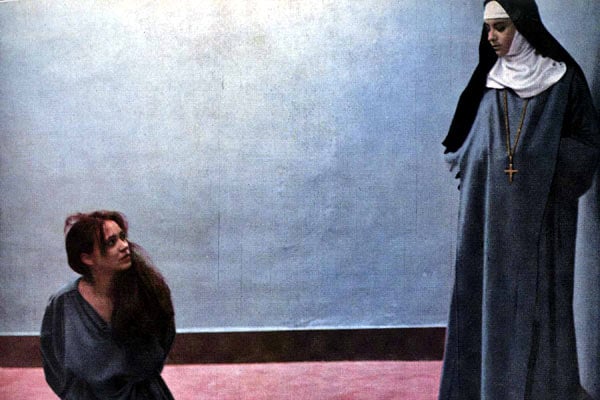
Elements in the same pattern can be found in some of Rivette’s other films as well. Substitute the Catholic church for the theater (and the 18th century for the 20th) and you get The Nun (1966), Rivette’s adaptation of the Denis Diderot novel; substitute two female buddies sharing an apartment and identities and you get his riotous comedy Celine and Julie Go Boating (1974). Yet the most remarkable thing about Rivette’s filmography is its wide range despite these similarities.
The formal explorations carried out from The Nun, his second feature, through Noroit (1976), his eighth, represent one of the most thrilling sustained adventures in modern cinema. Each chapter in the adventure is a self- conscious heightening of one or more of the basic pleasures of movies, each set in relief by a different process: combining elements of fiction and documentary (L’amour fou); getting the actors to invent their own characters and improvise their own lines (both versions of Out 1) or collaborate on the script (Celine and Julie Go Boating) or share the screen with improvising musicians (Noroit).
I would argue that of all the Cahiers du Cinema critics who became filmmakers Rivette is, after Godard, the most important — more interesting and compelling than Francois Truffaut, Eric Rohmer, or Claude Chabrol, although his works are much less known than theirs. But I have to confess to a certain ambivalence about The Gang of Four. As a virtual anthology of Rivettean themes and patterns, it represents the first case of outright repetition in his career, and suggests that after three decades he has finally worked his way back to a more “classical” or conventional style of direction, like that of his first feature, Paris Belongs to Us. He’s obviously gained a great deal of mastery as a director in the meantime, but lost some spirit of adventure. The Gang of Four, one of his most accessible movies, can be an excellent introduction to his work as a whole; but it’s less impressive if you already know that work.
The theater group in The Gang of Four is an acting class in Paris run by a legendary, Svengali-like teacher named Constance Dumas (Bulle Ogier, who has appeared in seven of Rivette’s films). Her students, all young women, are played by real acting students, nearly all of them making their screen debuts here. Constance is directing her students (who play both the male and female roles) in a Marivaux play whose French title, La double inconstance (“Double Infidelity”), plays on her own name.
Four of the students — Cecile (Nathalie Richard), Anna (Fejria Deliba), Joyce (Bernadette Giraud), and Claude (Laurence Cote) — share a small house in the country and commute daily by train to the tiny theater where they rehearse with Constance. Near the beginning of the film, Cecile moves out to live with her lover, whom no one has ever seen, and Lucia (Ines de Medeiros) — another acting student, from Portugal–takes over her attic room. A bit later, Anna goes to a party and meets a mysterious man named Thomas (Benoit Regent), who drives her home. Gradually becoming involved in one way or another with all the students in the house, he embodies the ambiguous offscreen conspiracy that eventually affects them all — including Cecile and Constance — and is in fact the only male character of any importance in the film.
Like most of Rivette’s plots, this one is extremely complicated and mysterious, and, in the final analysis, rather gratuitous and artificial — a sort of diabolical mechanism reduced to its barest functionalism rather than a story that we can follow or believe in any ordinary sense. We’re never entirely sure whether Thomas is a crook or a cop; whatever he is, he represents an intrusion and a threat that the women all eventually have to come to terms with — violently, in fact.
To understand and appreciate the power of The Gang of Four, and Rivette’s work in general, one must consider a much broader and widely misunderstood branch of cinema — the cinema of personal obsession. When I say personal obsession, I’m not talking about a director’s offscreen behavior, I’m talking about style, form, and content. My Webster’s defines “obsession” as “a persistent preoccupation with an often unreasonable idea or feeling,” and that comes pretty close to what I mean if you include a hypnotic absorption with a way of seeing things. Most if not all of the obsessions I have in mind tend to be sexual and/or morbid in orientation, involving voyeurism and/or fetishism; they give the impression that a director could happily gaze at a specific person or object or activity forever.
According to the conventional wisdom, the progression of commercial movies over the last 75 years represents steady improvement, a series of gains: sound, color, wide-screen ratios, special effects, and so on. But this so- called progression is paralleled by an almost equally steady decline in the mass audience’s interest in the cinema of personal obsession.
Consider the evidence: 1915 was the year of The Birth of a Nation and the first episodes of Louis Feuillade’s Les vampires — both extremely personal and obsessive works that were nonetheless totally in tune with the predilections of the mainstream — and 1918 brought Blind Husbands, the successful directorial debut of Erich von Stroheim, probably the most obsessive of all filmmakers. The 20s ushered in the first mature works of such gifted obsessives as Tod Browning, Carl Dreyer, Sergei Eisenstein, and Josef von Sternberg. But the 30s, after beginning with a few key works by these same figures (Freaks, Vampyr, the unfinished Que Viva Mexico, and The Blue Angel respectively), gradually gave way to calculation and compromise, e.g., Eisenstein’s Alexander Nevsky (though it was eventually followed by the genuine obsessiveness of Ivan the Terrible in the 40s), or simple inactivity. (Dreyer made one film per decade for the next 30 years; Stroheim made no more films at all.) Though Sternberg managed to be more prolific than the others, it was only because one aspect of his obsession, Marlene Dietrich, happened to coincide with mainstream taste; once his association with Dietrich ended, his career ran aground.
Nowadays, the obsessions of filmmakers are suppressed in favor of the calculations of bankers and the more scattered whims of stars, such as Eddie Murphy, Bill Murray, Sylvester Stallone, and Warren Beatty, who produce, and sometimes direct and/or write, their own pictures. These “auteurs” may fuss over their own close-ups and (in some cases) interfere with the creative work of the people they hire, but they lack the conviction and consistency of obsessive artists. The same goes for such directors as Woody Allen, Michael Cimino, and Brian De Palma, whose mulish reliance on their models is too unimaginative to qualify as artistry (although they might correctly be called obsessive copycats). I’m not trying to deny that some contemporary commercial American movies have certain obsessive qualities; but few of these obsessions are genuinely personal and artistic. Also, when certain obsessions are genuinely and widely shared — such as the racial and sexual hysteria of The Birth of a Nation, or current preoccupations with money — they’re less likely to be regarded as such.
Contemporary obsessive filmmakers tend to be marginal rather than mainstream figures — Chantal Akerman, Kenneth Anger, Robert Bresson, Leos Carax, John Cassavetes, Georges Franju, Mark Rappaport, Jacques Rivette, Andrej Tarkovsky — or else mainstream in a peculiarly closeted and secretive way, like Stanley Kubrick, Jerry Lewis, and Elaine May. Sad to say, Carax — whose career is currently at a standstill after only two features (Boy Meets Girl and Bad Blood) — is the only one in the above list under 40, and there are plenty of reasons to fear that this kind of filmmaking may be on the verge of extinction. (The main institutions in support of marginal cinema in this country, from the Village Voice to the NEA, are currently in the process of withdrawing or at least minimizing their support.)
Rivette’s The Gang of Four and Alejandro’s Jodorowsky’s Santa sangre, both in town this week in limited engagements — the former at the Film Center, the latter at the Music Box — represent, respectively, genuine and bogus examples of what the best obsessive cinema is all about. Santa sangre, which seems too calculated to qualify as obsessive or even compulsive but is sensationalist nonetheless, is getting more attention and exposure, and will probably attract more customers. After all, real obsessive filmmaking tends to be pretty scary stuff, and most spectators would rather be titillated than scared.
Among the most common traits of the best obsessive cinema are slowness (with notable exceptions, such as Griffith and early Eisenstein), lengthy running times, the kind of lingering, neurotic intensity that makes the films register most strongly a day or more after one sees them, and a sense of anxiety and dread that is related (but not necessarily identical) to suspense. The experience imparted by this kind of work is often both a dreamlike feeling of suspension and a sense of being caught inside a ferocious psychic energy that can’t be adequately accounted for by the plot or the characters. Rivette himself once expressed this disturbing sensation perfectly in an interview when he remarked, “The role of a work of art is to plunge people into horror. If the artist has a role, it is to confront people — and himself first of all — with this horror, this feeling that one has when one learns about the death of someone one has loved.”

Nothing could be further from this than a campy sub-Fellini circus like Jodorowsky’s Santa sangre, which, like his previous El topo (1971) and The Holy Mountain (1973), is very easy to watch and almost impossible to remember afterward. Chock-full of morbid surrealistic details (like a dying elephant’s trunk ejaculating blood to cap a sex scene) and other pretensions, it is largely devoted to the task of convincing one of its obsessiveness — it’s the work of a charlatan who habitually sells himself as a mystic visionary and piles on as many graphic shocks as possible. (The paradox, of course, is that the true obsessive, like Rivette, is usually too bound up in his or her obsessions to be concerned with “convincing” the viewer of anything.) The Mel Brooks of Mexican pop surrealism, Jodorowsky always follows the premise that if you hit the audience with 30 outrageous ideas in a row, 2 or 3 are bound to work (personally, I found the elephant’s funeral charming, until Jodorowsky spoiled it with overkill). But unlike Brooks — and closer to such programmatic postsurrealists and poseurs as Fernando Arrabal and Shuji Terayama — he has no sense of humor, much less an interesting sensibility (which prevents him from qualifying even as a bargain-basement Luis Bunuel, despite the fact that both filmmakers share a surrealist taste for obsessed characters without necessarily being truly obsessed themselves). There are plenty of laughs in Santa sangre, but few if any of them appear to be intentional.
The genre that Santa sangre belongs to might be described as the S and M circus story. (Other, better examples would include Browning’s The Unknown and Freaks, Victor Sjostrom’s He Who Gets Slapped, Edmund Goulding’s Nightmare Alley, Bergman’s Sawdust and Tinsel/The Naked Night, De Mille’s The Greatest Show on Earth, and Kurt Neumann’s Carnival Story.) Filmed in Mexico, in English (the title translates as “holy blood”), the story concerns a crazed magician named Fenix (played at separate ages by Jodorowsky’s sons Axel and Adan) who is traumatized as a child when his father mutilates his mother, then commits suicide. His religious fanatic mother Concha (Blanca Guerra), who worships an armless saint, catches her husband (Guy Stockwell), a circus owner, making love to the tattooed lady (Thelma Tixou) and pours acid on his penis. He retaliates by slicing off her arms, then kills himself. (In the comic-book world of Jodorowsky, such extravaganzas are everyday occurrences.) To make matters worse, young Fenix must now leave his beloved Alma (Sabrina Dennison), the tattooed lady’s deaf-mute harlequin daughter, who functions in the movie as a sort of all-purpose Fellini muse and Ideal Woman, better seen than heard.
After spending most of his life in an insane asylum, where he crouches naked on an uprooted tree and devours raw fish, Fenix escapes. He coincidentally passes the armless Concha on the street and joins her in a music-hall act where he stands behind her replacing her lost arms with his own. Meanwhile, he just happens to run into and murder the tattooed lady. He gradually becomes Concha’s psychic Siamese twin, unable to resist doing her bidding — which includes her knitting and piano playing, as well as murdering a flock of women and painting them all white in their coffins, until he runs into redemptive Alma again. You can probably figure out the rest, including the symbolism of all the characters’ names, although you’d never predict the closing biblical quote (the screen says from Psalms 143.6.8, if you want to look it up).
What are the obsessional aspects of Rivette’s movies, The Gang of Four in particular, apart from the overall structural patterns described above? Three traits in particular come to mind:
An infatuation with actresses that’s voyeuristic without ever being pornographic. This extends on occasion to a certain fascination with actresses assuming and mocking or otherwise challenging traditional male roles. Noroit, to cite one example, centers on a band of female pirates. In The Gang of Four, the actresses assume male roles not only in the Marivaux play they’re rehearsing, but also in a mock trial they improvise at their house, involving patriarchal figures such as Thomas, the judge, the prosecutor, and the jury foreman.
A recurring dialectic between collectivity and utter solitude. Something of a recluse (as well as a compulsive moviegoer), Rivette himself tends to be a solitary creature when he is not making films, and the relationship between collective endeavors and the loneliness that exists apart from them is a constant in his work. The absence of certain locations in The Gang of Four — principally the homes of Constance, Cecile, and Thomas — are every bit as important as the compulsive recurrence of certain settings: the theater, a nearby cafe, and the house in the suburbs. Constance is never seen outside the theater, and the principal image of (apparent) solitude in the film — shots taken from a moving commuter train that recur with sinister frequency, echoing the credits sequence of Paris Belongs to Us — chills us to the bone. (There’s no logical reason why the actresses are never seen commuting together, and it’s difficult to pinpoint why these point-of-view shots convey such a sense of desolation and loneliness, but they do.)
A virtual agnosticism about reality itself. It’s a paradox in many of Rivette’s films that rehearsals often seem more real than the world outside them; whatever uncertainties they may contain or reveal, these are uncertainties that can usually be dealt with. The uncertainties in the world outside, by contrast, are so vast that they become terrifying and immobilizing, whether these are matters of conspiracy or one’s own isolation. (And what is “conspiracy,” after all, but a collectivity from which one is excluded?) Indeed, the aforementioned shots from the train, which increasingly occur at night, have an almost supernatural feeling, as if the unseen traveler were crossing the river Styx.
Most of Rivette’s movies up through Out 1 (both versions) show an acute sensitivity to the precise period in which they were made. This is especially true of Out 1 — no other films bear more eloquent witness to the exhilaration and subsequent disillusionment of Parisians in relation to May ’68 — but check out Paris Belongs to Us, the only Rivette film available on video, for a highly evocative view of France in the late 50s. The loss of this contemporary/phenomenological dimension in his more recent films makes them a good deal more claustrophobic and metaphysical in their implications — an unfortunate development for a materialist filmmaker who remarked in 1962 that he believed in a spiritual domain only in terms of the concrete. By and large, the evocations of ghosts that crop up in Rivette’s work with increasing frequency since Celine and Julie Go Boating, and which figure in the suburban house in The Gang of Four, correspond fairly closely to an increasing avoidance of politics.
Nearly all of the obsessive traits cited above (and one could surely think of others) come together in the film’s beautiful opening sequence, which shows Anna alone in a cafe finishing and paying for her coffee, walking down an empty cobblestone street, passing through a door, going up some dark steps and through another door, taking off her jacket, and proceeding to rehearse a dialogue with another student without missing a beat, before we even realize where she is. This passage from “life” to “art” is so ambiguous that we can never be sure when the precise change takes place, but at least Rivette shows us the whole process without cheating — unlike those elliptical, bloodcurdling, and mystifying train shots between city and suburb, when we might as well be drifting through outer space.


